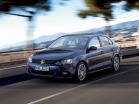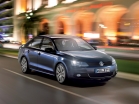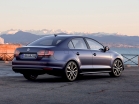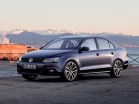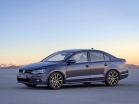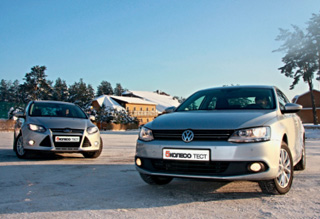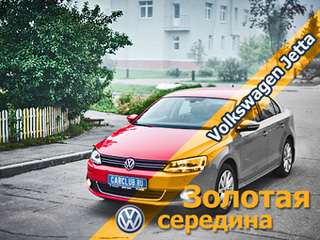Volkswagen Jetta test drive since 2010 sedan
Volkswagen Bora, or the wind of change
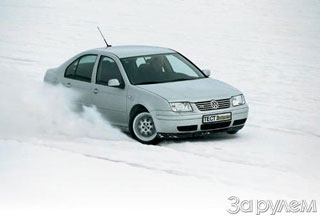 The car on the Volkswagen-Golf IV platform with the sedan body is represented in the fall of 1998 in Paris. Initially, it was only proposed in the front -wheel drive version with 1.6 gasoline engines; 2.0; 2.3 l (VR5) and two turbodieselles with a direct injection of 1.9 liters - 66 and 81 kW (90 and 110 hp). Later, 1.8 liter gasoline and the latest diesel with pumps of 1.9 l - 85 kW/115 liters were added. With. Soon there will be all -wheel drive modifications and the most powerful boron with the new VR6 engine (150 kW/204 h.).
The car on the Volkswagen-Golf IV platform with the sedan body is represented in the fall of 1998 in Paris. Initially, it was only proposed in the front -wheel drive version with 1.6 gasoline engines; 2.0; 2.3 l (VR5) and two turbodieselles with a direct injection of 1.9 liters - 66 and 81 kW (90 and 110 hp). Later, 1.8 liter gasoline and the latest diesel with pumps of 1.9 l - 85 kW/115 liters were added. With. Soon there will be all -wheel drive modifications and the most powerful boron with the new VR6 engine (150 kW/204 h.). In fact, Bora - the replacement of the Volkswagen -Vento, who replaced Jett, who, in turn, was nothing more than golf II with a protruding trunk. The markets dictate different requirements: if in most European Hatchback countries more than sedanov, then in America - vice versa. Our fellow citizens also prefer a three -breeze body, although the car industry until recently was not very considered their requests.
Bora, as in the recent past Vento, externally differs from the father of the Golf family. Rectangular headlights, another radiator cladding - these were the characteristic features of sedans based on golf. However, if Vento was known in all respects with a practical car, not distinguished by an exquisite design, then Bora looks much more elegant. A rapid wedge -shaped silhouette, powerful selecting wheeled niches, a short upturned back and widely arranged huge wheels 205/55R16 will not allow it to get lost in the flow of cars.
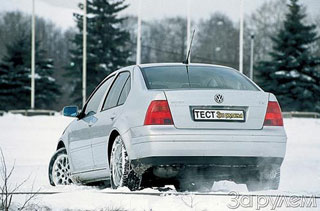 But the main attraction of the bore under the hood: a five -cylinder engine with a 2.3 l with a capacity of 110 kW/150 liters. With. This is a modification of the famous VR6 with a collapse angle of only 15, in which one cylinder was cut off. It is quite difficult to balance such a motor. It would seem, why such a Volkswagen, when he already has a wonderful 1.8t with a turbocharged low pressure, developing the same power, but with the best torque and more economical? If you reason theoretically, everything seems to be so. But if you get behind the wheel, it will immediately become clear that no turbo and five valves with a cylinder will replace an excess of working volume. Confident craving from the bottom is not available to the toss engine, no matter how they are wise with the gas distribution and regulation of the turbine. VR5 pulls, like a locomotive, with idle until the limiter is triggered, despite the fact that it has only a dozen valves and no tricks at the inlet. Yes, and a special vibration of the motor with the wrong number of cylinders is not noticeable, unless a specific voice at high speeds can suggest that under the hood is not four and not six.
But the main attraction of the bore under the hood: a five -cylinder engine with a 2.3 l with a capacity of 110 kW/150 liters. With. This is a modification of the famous VR6 with a collapse angle of only 15, in which one cylinder was cut off. It is quite difficult to balance such a motor. It would seem, why such a Volkswagen, when he already has a wonderful 1.8t with a turbocharged low pressure, developing the same power, but with the best torque and more economical? If you reason theoretically, everything seems to be so. But if you get behind the wheel, it will immediately become clear that no turbo and five valves with a cylinder will replace an excess of working volume. Confident craving from the bottom is not available to the toss engine, no matter how they are wise with the gas distribution and regulation of the turbine. VR5 pulls, like a locomotive, with idle until the limiter is triggered, despite the fact that it has only a dozen valves and no tricks at the inlet. Yes, and a special vibration of the motor with the wrong number of cylinders is not noticeable, unless a specific voice at high speeds can suggest that under the hood is not four and not six. The salon of even a standard bore deserves a separate description - what can we say about the configuration of Ful Opshn. The car we managed to meet, it clearly exceeds the standards of this class. River leather seats with electric heating and adjustment with memory for three positions, climate control, leather inserts in the doors, chrome pens, expensive plastic and inserts for a black tree on the front panel, colored 5-inch monitor for audio and navigation systems, 10 speakers And a separate multi -channel amplifier - a list of all attributes of a European lifestyle will take another page. About four airbags, belt tensioners and their height adjustment is unnecessarily mentioned.
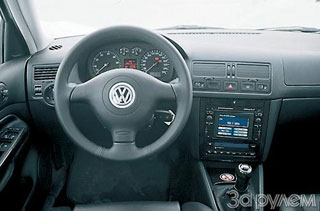 The driver’s place, composed in the best German traditions, is soundly and spacious. The seats of the bore, although very stringent, are very convenient for drivers of various complexions due to the large range of adjustments. Even the developed lateral stops do not interfere with the planting and ease - they are more embossed on the back than on the pillow, and impeccably fix the body in steep turns. The only thing is - it is better to take off outer clothing, otherwise, when accelerating the knot of the coat, it can leave the fingerprint on the back. But this is no longer a miscalculation of ergonomics, but the merit of the motor. Recall that the folkvagenes of Bora and the golf, as well as Audi A3 and Skoda Octavia have the same platform. Therefore, despite the different types of body, they have a common drawback - there is little space for the legs of passengers in the back seat. If in front of Bor people are swaying tall above the average, full -fledged places from behind will turn into children's. And a solid plastic on the back of the backs is not the best stop for the knees.
The driver’s place, composed in the best German traditions, is soundly and spacious. The seats of the bore, although very stringent, are very convenient for drivers of various complexions due to the large range of adjustments. Even the developed lateral stops do not interfere with the planting and ease - they are more embossed on the back than on the pillow, and impeccably fix the body in steep turns. The only thing is - it is better to take off outer clothing, otherwise, when accelerating the knot of the coat, it can leave the fingerprint on the back. But this is no longer a miscalculation of ergonomics, but the merit of the motor. Recall that the folkvagenes of Bora and the golf, as well as Audi A3 and Skoda Octavia have the same platform. Therefore, despite the different types of body, they have a common drawback - there is little space for the legs of passengers in the back seat. If in front of Bor people are swaying tall above the average, full -fledged places from behind will turn into children's. And a solid plastic on the back of the backs is not the best stop for the knees. What, in this case, did the rather large (4.38 m) length of the car? It turns out on the trunk. True, it is slightly less than that of Vento, but it has an almost perfect shape of a rectangular parallelepiped. A rather high threshold of the compartment from the inside is protected by a metal lining and can withstand repeated contact with heavy suitcases. Under a rigid rug - a full -size reserve, a jack and a minimum of the tool. If such a trunk is not enough, you can fold the rear seat, in parts or the whole.
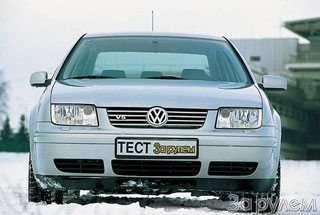 Unfortunately, the weather did not let the car on dry asphalt, where low-profile tires of Michelin-pilot-HX could prove themselves in all its splendor, but the controllability of the car on slippery roads was at the level. Bora has a sharp wheel with a good reactive effect and a huge margin stability. It is not easy to get the car out of balance, and it stabilizes almost without the participation of the driver. If you work as a steering wheel and gas, as expected, then the car on ice can even be pulled out of a skid by more than 90. On the other hand, it is almost impossible to force the car in a slippery turning of gas.
Unfortunately, the weather did not let the car on dry asphalt, where low-profile tires of Michelin-pilot-HX could prove themselves in all its splendor, but the controllability of the car on slippery roads was at the level. Bora has a sharp wheel with a good reactive effect and a huge margin stability. It is not easy to get the car out of balance, and it stabilizes almost without the participation of the driver. If you work as a steering wheel and gas, as expected, then the car on ice can even be pulled out of a skid by more than 90. On the other hand, it is almost impossible to force the car in a slippery turning of gas. On the roads with a higher coefficient of adhesion of the reaction of the bore become more sharp. A hard suspension allows you to confidently pass complex turns and at the same time retains an acceptable level of comfort. At least, she successfully copes not only with small irregularities and waves, but also with sharp chips and small potholes. There is no need to require more off -road qualities from a hundred -fed -strong bore. Her element is asphalt. And here there are few competitors.
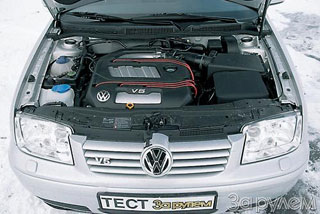 TECHNICAL SPECIFICATIONS
TECHNICAL SPECIFICATIONS General data: number of places - 5; Equipped mass - 1227 kg; Full mass - 1825 kg; maximum speed - 216 km/h; acceleration time from a place to 100 km/h - 9.2 s; fuel consumption in conditional suburban and city cycles - 7.2; 13.2 l/100 km; fuel supply - 55 liters; Fuel is unhealthy gasoline AI-95, AI-92 is allowed. Dimensions, mm: length - 4376; width - 1735; height - 1446; base - 2513; The track in front/back - 1513/1494; Road clearance - 130; trunk volume - 455/785 l; The turning radius is 5.5 m. The engine: with a collapse angle 15 (VR5) with distributed injection, two valves on the cylinder, is located in front of the front; working volume - 2324 cm; cylinder diameter and piston stroke - 81.0x90.2 mm; compression degree - 10.1; Power - 110 kW/150 liters. With. at 6000 rpm; The maximum torque is 205 N.M at 3200 rpm. Transmission: front wheel drive; gearbox - mechanical five -speed; Transporting numbers: I - 3.30; II - 1.94; III - 1.31; IV - 1.03; V - 0.84; h. X. - 3.06; The main program is 3.94. Suspension: with reproach stabilizers, in front - an independent type of mcesson, from behind - longitudinal levers connected by an elastic transverse beam. Brakes: disk with an amplifier and ABS, in front - ventilated. Steering: rheck with an amplifier. Tire size: 205/55R16.
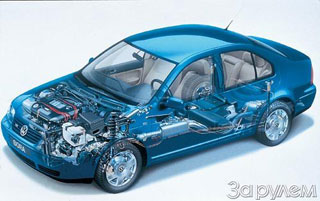 SUMMARY
SUMMARY Volkswagen Bora is a stylish small sedan with a luxurious salon, a powerful engine and quite pronounced sports ambitions. Moreover, for reasonable money - after all, say, BMW -323i in the same configuration costs twice (!) More expensive. And comparing it with other competitors is simply unsolvable. Volkswagen achieved his: the difference between prestigious and mass machines became elusively thin.
+ A powerful, thrust engine, well-chosen gear rates in the gearbox, effective brakes, luxurious equipment of the cabin, high build quality, accurate and fast steering wheel, and the permissibility of the use of 92nd gasoline.
- Close-on-back salon, a small trunk opening, a small road clearance, a low apron under the front bumper, the climate control display is poorly visible from the driver's seat.
Anatoly Fomin.
Photo by Sergey Ivanov
Source: The magazine "Driving"

